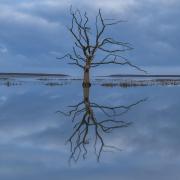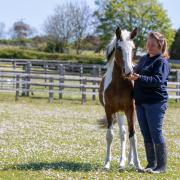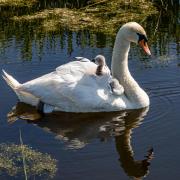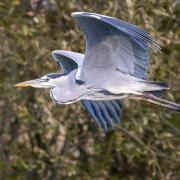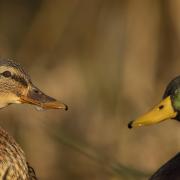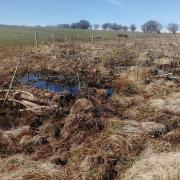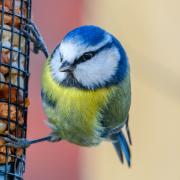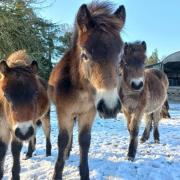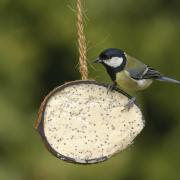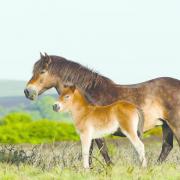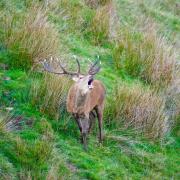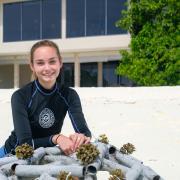Rachael Sharpe heads to Exmoor Owl & Hawk Centre and discovers a kind, natural way of working with animals

It’s hard to imagine anywhere more idyllic than West Lynch Farm, home to Exmoor Owl & Hawk Centre. The beautiful olde worlde 15th century farmhouse is picture perfect, nestled in one of the most beautiful spots in Exmoor National Park. It’s an abnormally hot day when we visit, with deep blue skies that make the green hues of the landscape pop. Walking up the garden path to the house, concentration is fixed on the beautiful bantam chickens parading around the gardens, so much so that we don’t notice the three brightly coloured macaws in the tree overhead until they start saying ‘hello, hello, hello’.
The house sits on a large plot with a small Chapel of Ease, surrounded by a collection of thatched and ancient tiled buildings forming three sheltered courtyards, which are home to Cathy Powell and Rod Smith’s animals. Cathy has lived at the farm for the past 22 years with Rod joining her nine years ago. Cathy, who won Somerset Business Woman of the Year Award back in 2000, explains that it’s a well-established business but it has changed over time. The business started out as a farm park but developed into a riding centre after the family brought their first horses. I learn that they’ve still got the first horses the family had 22 years ago, which I come to realise perfectly reflects the ethos of the centre – animals stay.
Rod uses what he calls ‘trust-based training’, where he works with the birds so that they behave as they would naturally and as he would like. The owls and hawks aren’t pets but there is a process of desensitising that’s vitally important - introducing the birds to their new environment and starting to work on the animal doing things when asked, so that they’ll fly to customers. “The centre becomes their territory and they are happy to fly within it,” explains Rod. I learn that it’s because Rod has manned the birds from an early age they’ve never learned to kill, which is why they are happy with the ducks, chicken, geese and swan wandering around this animal haven, which also features kunekune pigs, alpacas, Pygmy goats and miniature donkeys and Shetland ponies as well as the nine horses and 26 owls and hawks…
Rod brings African Spotted Eagle Owl, Sephoo (short for Sephooko - the South African Sesotho word for ‘owl’) to the table where we’re sitting enjoying the Somerset sunshine. Sephoo is a new addition, he was bred in England and arrived at the centre last week, at five weeks of age. He allows Rod to weigh him and jumps from one perch to another when asked and is held on the glove. Wearing a glove we hold him and appreciate the majesty of interacting with an animal like this who is untethered – something very special indeed.

Next we meet 23-year-old Dela (again derived from a South African name - Nelson Mandela!) who is another African Spotted Eagle Owl – an older version of Sephoo if you like. She flies out of her aviary onto the glove because she wants to – she’s not coaxed into it or collected. In the field she follows Rod by running on the ground behind him (it’s quite a sight) and will fly from table to table (where customers sit for demonstrations and displays). The fact that Rod has complete control over the bird while it’s untethered is amazing and a testament to his manning skills.
Thoroughly wowed by the owls we’ve met, we walk over to the horse yard, which is made up of an amazing collection of barns that house the nine horses that are lucky enough to live here. It’s a happy, calming place to be. Cathy’s horses are ridden bare foot and without bits, which means only confident riders can experience riding through the stunning but challenging terrain that surrounds the centre. “Like the birds, horses need all the groundwork of natural horsemanship to be done before they go out riding –natural horsemanship is all about trust. I learn that this natural way of working with animals is gentle and kinder, but as the animal, not the owner, leads the process it can be time consuming. Talking of when they switched to natural methods of horsemanship, Cathy explains that it was six years ago when they had a horse with bad thrush in its frogs (underside of the hoof) with big splits. It was suggested that the said horse be put to sleep, but unwilling to do this, Cathy started researching barefoot trimming, which was successful. This was to become a turning point and from then on all the horses were barefoot, despite it being a long process.
“Barefoot is more comfortable for the horse - frogs can grow and develop properly and act as a cushion,” she says.
Cathy demonstrates her natural horsemanship skills, which are nothing short of fantastic. Paps (short for Papoose, the Indian word for North American child) who is completely untethered, follows Cathy (who is on foot) around a small field, first a walk, then a trot, then into a small canter. Cathy asks him to do some agility, weaving in and out of poles and stepping backwards on her command.
Cathy also demonstrates how she uses pilates techniques on the horses. She asks Paps to lift his leg . When he does she takes it and gives it a lovely long stretch before moving to the next one. Afterwards she releases pressure from the horse massaging in a few key spots, which he seems to appreciate. Through this short demonstration we are able to see that natural horsemanship is incredibly rewarding for both owner and horse.
It’s hard to drag ourselves away from Exmoor Owl & Hawk Centre, but when we do we all find that the feeling of peace of tranquility you get from being in such a kind environment lasts for days – we almost wish we could move in...




